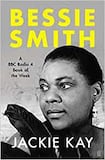
Anyone who knows the music of blues legend Bessie Smith will immediately recognise the poet Jackie Kay’s descriptions of its power, and how it feels to listen to that raunchy, passionate, tragic, fully alive voice. The songs feel, as Kay writes in her new biography, as though you are being “entrusted with a secret”. “You listen so hard she practically inhabits you; her very soul seems to find a way inside you.”
I first fell in love with Bessie Smith at university. I remember hearing that voice, by turns soft, then growling, then wailing, and being entranced. Online, I found a video of Smith, sitting on the floor by her bed, downing gin, singing to herself. “My man’s got a heart like a rock cast in the sea.” I felt like it was just me and her.
It seems as though every lover of Smith goes through the same journey. It’s impossible not to be haunted, enraptured. Who is this woman, full of wicked spite, humour, tragedy? Whose man leaves her, who tries to shoot at him from a moving train, who drowns herself in gin and eats pigs’ feet after midnight in a boozy lock-in?
It’s the skill of Kay’s biography to capture that sense of initial charge and identification, that conspiratorial relationship between Smith’s blues and her listeners, who can never feel alone, so long as Smith is beside them. We feel Smith’s personality electrifying these pages: she is brought, uncannily, back to life. Kay manages to imbue this biography with the full force of personhood. It reads, in some places, like a novel, in that we feel intimately aware not only of the facts of Smith’s life, but of her motivations, her fears, her demons, and her magnetic, forceful individuality.
Smith was a woman whose life, as Kay writes, “lent itself to legends”: “Her life so aptly corresponded with her times that each seems emblematic of the other.” Charting her career, her songs, her tumultuous relationships to men, women, and alcohol, Kay’s biography is interspersed with poetry, lyrics, vignettes and a tantalising psychological speculation.
Though the book weaves a biography of Smith with threads of Kay’s own autobiography, the effect is not intrusive. Rather, it deepens Smith’s elusive appeal with the sense of a search for meaning, a search for personality, the tracing of a matrilineal connection between a young poet in Scotland and a long-dead blues singer in 1920s America. “Any time I came across a black person, usually on TV”, Kay writes, “I tried to work out their relationship to me. I concocted an imaginary black family for myself.”
The reason that this works so well is that Kay’s attentiveness to Smith draws out the radicalism and complexity of the singer, her life, and the blues. The journey from blues to jazz, for example, might be “a metaphor for that fluidity in our own gendered identities”.
Much of Smith’s archive is lost, and the songs were recorded without editing, hence their rawness, their magnetic quality. The lacunae in Smith’s biography are threaded through by Kay with readings of the lyrics, attention to the voice, but also with a series of open questions, drawing our attention to the person behind the music. Who did she have sex with? What were the women’s names? Why did her husband burn her papers? What exactly was in that archive? By pointing to the gaps, Kay builds a searching, sensitive and inquisitive biography, conjuring Smith to live between the lines.
The eerie tandem between Smith’s life and the songs she recorded fuels a fascinating investigation into the almost prophetic relationship between the singer and the song, between the music and the times. “The blues that Bessie sang often strangely anticipated her life. She became her blues. Or perhaps she always was her blues. So many of the tragedies she sang about actually happened to her after she sang the songs and not before.”
Domestic abuse, alcoholism, cheating men, poverty. This intimately intertwined relationship sees Smith not just as the embodiment of the music, but the embodiment of her time and social situation. As Kay writes, “no need for a glass ball when you’ve got the blues”.











